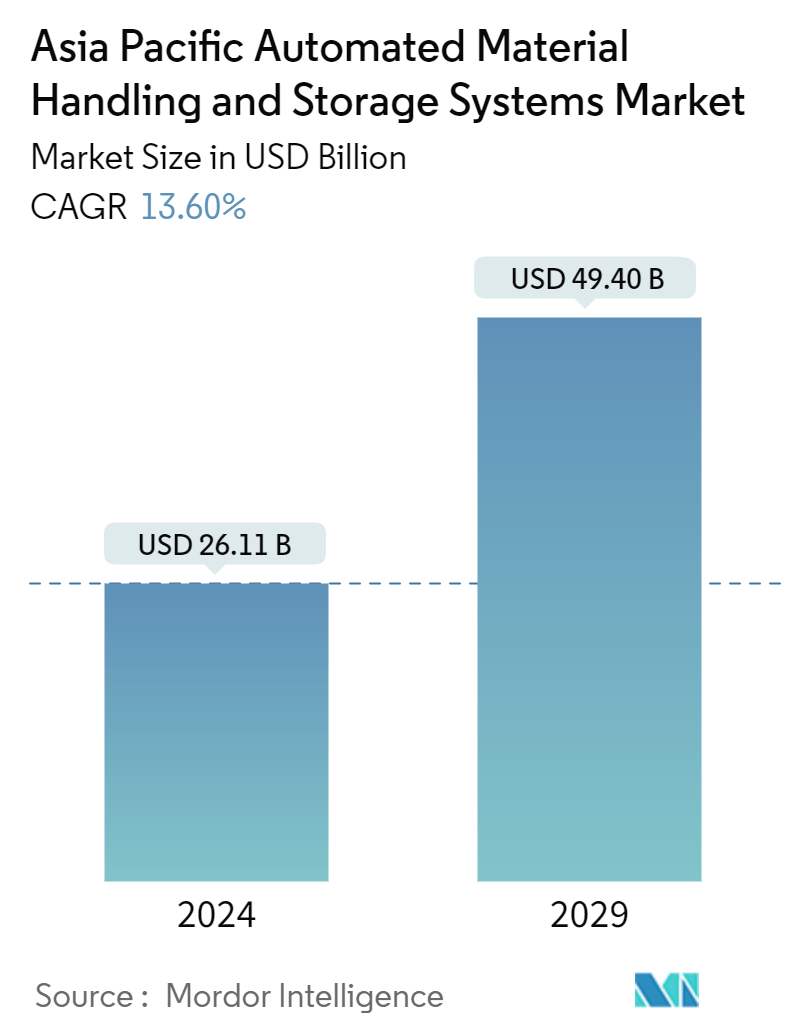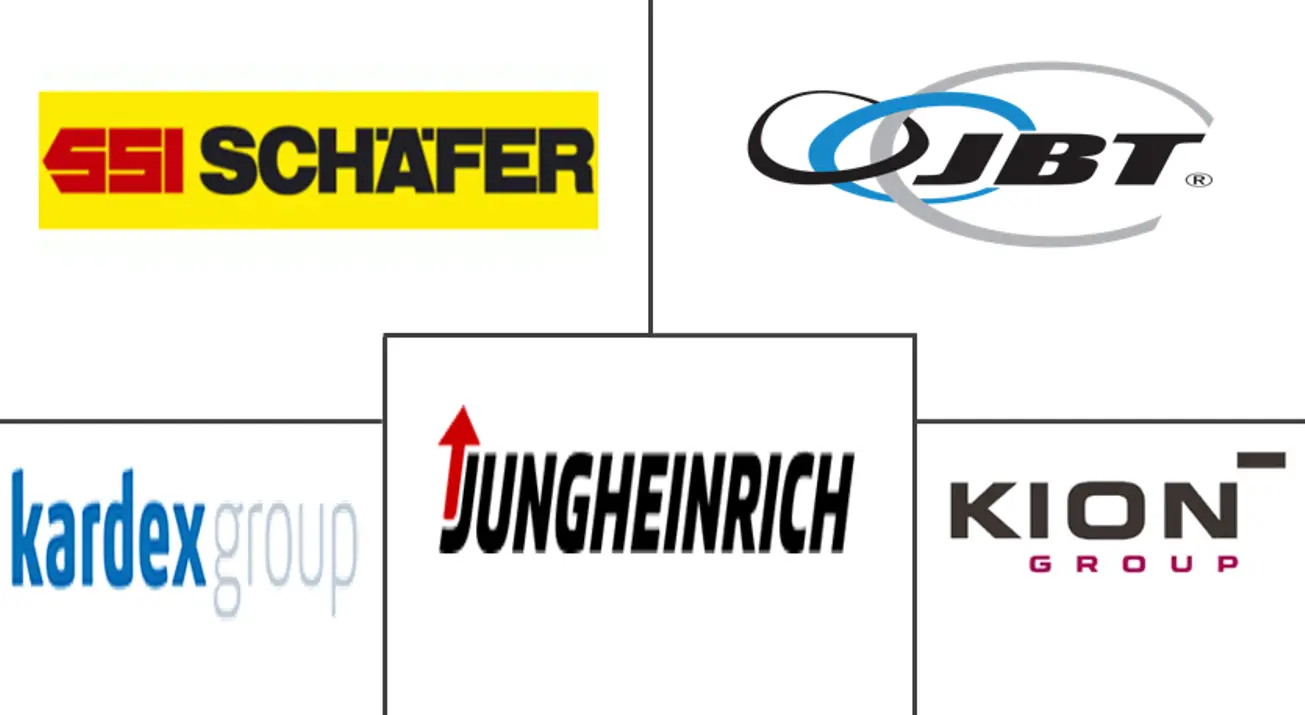Market Size of Asia Pacific Automated Material Handling And Storage Systems Industry

| Study Period | 2022 - 2029 |
| Base Year For Estimation | 2023 |
| Market Size (2024) | USD 26.11 Billion |
| Market Size (2029) | USD 49.40 Billion |
| CAGR (2024 - 2029) | 13.60 % |
| Market Concentration | Low |
Major Players
*Disclaimer: Major Players sorted in no particular order |
APAC Automated Material Handling & Storage Systems Market Analysis
The Asia Pacific Automated Material Handling And Storage Systems Market size is estimated at USD 26.11 billion in 2024, and is expected to reach USD 49.40 billion by 2029, growing at a CAGR of 13.60% during the forecast period (2024-2029).
With the rapid growth in stock-keeping units (SKUs), wholesalers and distributors are finding it difficult to make informed decisions about operations. This dilemma underscores the pressing need for more efficient labor, equipment, and technology utilization. Key factors driving the need for automated material-handling systems include cost savings, enhanced labor efficiency, and space optimization.
The market landscape is witnessing a surge in product variety and a demand for more frequent, smaller deliveries. Automated distribution operations can significantly boost an organization's order accuracy, often by several percentage points. The Asia-Pacific market’s growth is propelled by urbanization, surging e-commerce sales, and a robust technology provider presence. These providers are intensifying their R&D efforts to offer cutting-edge solutions and maintain a competitive edge.
Asia-Pacific has cemented its position as a global e-commerce powerhouse. This status has been bolstered by the region's expanding retail e-commerce, driven by a burgeoning middle-income group in countries like China, India, and Indonesia, coupled with a fondness for mobile devices. Notably, China commands a staggering 40% share of global retail e-commerce sales. In several Asia-Pacific nations, the availability of warehouse land is dwindling, prompting a shift toward multi-story facilities and taller, narrower aisles. These adaptations are poised to fuel the demand for advanced material handling systems.
Material handling has witnessed a profound evolution over the past seven decades, with machines and robots increasingly replacing individual workers. This transformation has not only reshaped the industry but also fueled the growth of enterprises, notably in the automotive industry, which has seen a tenfold expansion. Countries like India are significantly investing in material handling equipment, with the MHE market, as per the Wisconsin Economic Development Corporation, capturing around 13% of the country's construction equipment industry. Southeast Asian nations, including Thailand, the Philippines, and Vietnam, are witnessing a surge in manufacturing establishments, bolstering employment and, subsequently, disposable incomes. This rise in income, coupled with a growing awareness of international brands, is spurring demand for local warehouses.
Indonesia stands out as a nation swiftly embracing automation, with a notable uptick in robotic usage for industrial applications. Given Japan's dual role as both a supplier and a consumer, Indonesia stands to benefit from heightened trade activities, further propelling the region's automation demand.
The global industrial landscape faced significant disruptions due to the COVID-19 pandemic and ensuing lockdowns. These disruptions spanned supply chain challenges, raw material shortages, labor scarcities, fluctuating prices, and shipping bottlenecks, all of which threatened to inflate production costs and exceed budgets.
APAC Automated Material Handling & Storage Systems Industry Segmentation
Automated material handling equipment streamlines operations by reducing human intervention. The growing appetite for automation, bolstered by advancements in robotics, wireless tech, and autonomous vehicles, has reshaped industries spanning food and beverages, retail, manufacturing, pharmaceuticals, and logistics.
The Asia-Pacific automated material handling and storage systems market is segmented by product type (hardware, software, services), by equipment type (mobile robots (automated guided vehicles (automated forklift, automated tow/tractor/tug, unit load, assembly line, special purpose), autonomous mobile robots), automated storage and retrieval systems (fixed aisle, carousel, vertical lift module), automated conveyors (belt, roller, pallet, overhead), palletizer (conventional, robotic), sortation system), end-user industry (airport, automotive, food and beverage, retail/warehousing/distribution centers/logistics centers, general manufacturing, pharmaceuticals, post and parcel, electronics and semiconductor manufacturing, other end-user industries), and country. The market sizes and forecasts are provided in terms of value (USD) for all the above segments.
| Product Type | |
| Hardware | |
| Software | |
| Services |
| Equipment Type | ||||||||||
| ||||||||||
| ||||||||||
| ||||||||||
| ||||||||||
| Sortation System |
| End-user Industry | |
| Airport | |
| Automotive | |
| Food and Beverage | |
| Retail/Warehousing/Distribution Centers/Logistic Centers | |
| General Manufacturing | |
| Pharmaceuticals | |
| Post and Parcel | |
| Electronics and Semiconductor Manufacturing | |
| Other End-user Industries |
| Country | |
| China | |
| Japan | |
| Indonesia | |
| India | |
| Australia | |
| Thailand | |
| South Korea | |
| Singapore | |
| Malaysia | |
| Taiwan | |
| Rest of Asia-Pacific |
Asia Pacific Automated Material Handling And Storage Systems Market Size Summary
The Asia-Pacific Automated Material Handling and Storage Systems Market is poised for significant expansion, driven by the increasing complexity of supply chain operations and the need for enhanced efficiency. The region's rapid urbanization, burgeoning e-commerce sector, and the presence of numerous technology providers are key factors propelling market growth. As the demand for more frequent and smaller deliveries rises, businesses are increasingly turning to automated solutions to improve order accuracy and streamline operations. The limited availability of land for warehousing in some countries is prompting the development of multi-story facilities and narrower aisles, further boosting the demand for advanced material handling systems. This trend is particularly evident in countries like China, India, and Indonesia, where the middle-class population is growing, and mobile technology is gaining popularity.
The market is characterized by intense competition, with numerous players investing in research and development to offer innovative solutions. The automotive and aerospace industries are significant consumers of automated systems, driven by the need for flexibility and efficiency in production processes. The COVID-19 pandemic has accelerated the adoption of automation, as businesses seek to mitigate supply chain disruptions and labor shortages. Additionally, the aviation sector is witnessing increased investments in automated systems to enhance passenger experience and operational efficiency. The market's competitive landscape is marked by high barriers to entry and a concentration of firms, with key players like Kardex Group, KION GROUP AG, and Jungheinrich AG leading the charge in innovation and expansion.
Asia Pacific Automated Material Handling And Storage Systems Market Size - Table of Contents
-
1. MARKET DYNAMICS
-
1.1 Market Overview
-
1.2 Industry Value Chain Analysis
-
1.3 Industry Attractiveness - Porter's Five Forces Analysis
-
1.3.1 Bargaining Power of Suppliers
-
1.3.2 Bargaining Power of Consumers
-
1.3.3 Threat of New Entrants
-
1.3.4 Intensity of Competitive Rivalry
-
1.3.5 Threat of Substitute Products
-
-
1.4 Impact of COVID-19 on the Industry Ecosystem
-
1.5 Market Drivers
-
1.5.1 Increasing Technological Advancements Aiding Market Growth
-
1.5.2 Industry 4.0 Investments Driving Demand for Automation and Material Handling
-
1.5.3 Rapid Growth of E-commerce
-
-
1.6 Market Restraints
-
1.6.1 High Initial Costs
-
1.6.2 Unavailability of Skilled Workforce
-
-
-
2. MARKET SEGMENTATION
-
2.1 Product Type
-
2.1.1 Hardware
-
2.1.2 Software
-
2.1.3 Services
-
-
2.2 Equipment Type
-
2.2.1 Mobile Robots
-
2.2.1.1 Automated Guided Vehicle (AGV)
-
2.2.1.1.1 Automated Forklift
-
2.2.1.1.2 Automated Tow/Tractor/Tug
-
2.2.1.1.3 Unit Load
-
2.2.1.1.4 Assembly Line
-
2.2.1.1.5 Special Purpose
-
-
2.2.1.2 Autonomous Mobile Robots (AMR)
-
-
2.2.2 Automated Storage and Retrieval System (ASRS)
-
2.2.2.1 Fixed Aisle
-
2.2.2.2 Carousel
-
2.2.2.3 Vertical Lift Module
-
-
2.2.3 Automated Conveyor
-
2.2.3.1 Belt
-
2.2.3.2 Roller
-
2.2.3.3 Pallet
-
2.2.3.4 Overhead
-
-
2.2.4 Palletizer
-
2.2.4.1 Conventional
-
2.2.4.2 Robotic
-
-
2.2.5 Sortation System
-
-
2.3 End-user Industry
-
2.3.1 Airport
-
2.3.2 Automotive
-
2.3.3 Food and Beverage
-
2.3.4 Retail/Warehousing/Distribution Centers/Logistic Centers
-
2.3.5 General Manufacturing
-
2.3.6 Pharmaceuticals
-
2.3.7 Post and Parcel
-
2.3.8 Electronics and Semiconductor Manufacturing
-
2.3.9 Other End-user Industries
-
-
2.4 Country
-
2.4.1 China
-
2.4.2 Japan
-
2.4.3 Indonesia
-
2.4.4 India
-
2.4.5 Australia
-
2.4.6 Thailand
-
2.4.7 South Korea
-
2.4.8 Singapore
-
2.4.9 Malaysia
-
2.4.10 Taiwan
-
2.4.11 Rest of Asia-Pacific
-
-
Asia Pacific Automated Material Handling And Storage Systems Market Size FAQs
How big is the Asia Pacific Automated Material Handling And Storage Systems Market?
The Asia Pacific Automated Material Handling And Storage Systems Market size is expected to reach USD 26.11 billion in 2024 and grow at a CAGR of 13.60% to reach USD 49.40 billion by 2029.
What is the current Asia Pacific Automated Material Handling And Storage Systems Market size?
In 2024, the Asia Pacific Automated Material Handling And Storage Systems Market size is expected to reach USD 26.11 billion.
Automated Material Handling and Storage Systems Market in APAC Report Snapshots
- Automated Material Handling and Storage Systems Market in APAC Market Size
- Automated Material Handling and Storage Systems Market in APAC Market Share
- Automated Material Handling and Storage Systems Market in APAC Market Trends
- Automated Material Handling and Storage Systems Market in APAC Companies

